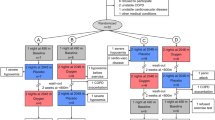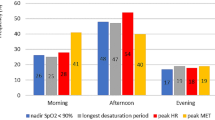Abstract
Purpose
To analyze the relationship between oxygen desaturation episodes during a laboratory-based ADL protocol and in real-life routine in patients with stable chronic obstructive pulmonary disease (COPD).
Methods
Twenty patients with stable COPD (12 men, 70 ± 7 years, FEV1% 54 ± 15 predicted) with no indication for long-term oxygen therapy (LTOT) were submitted to assessments including ADL performance by the Londrina ADL Protocol (LAP) and level of physical activity in daily life, both while submitted to simultaneous activity and pulse oximeter monitoring.
Results
Episodes of desaturation ≥ 4% (ED ≥ 4%) during the LAP were correlated both with ED ≥ 4% in daily life (r = 0.45) and number of episodes of SpO2 under 88% (ED < 88%) in daily life (r = 0.59). ED < 88% during the LAP was also correlated with ED < 88% in daily life (r = 0.51), explaining 43% of its variance.
Conclusion
In stable patients with COPD and no indication of LTOT, episodes of desaturation during a lab-based ADL protocol are moderately related to episodes of desaturation in daily (real) life, especially those episodes under 88%.


Similar content being viewed by others
References
Nakamura A, Kasamatsu N, Hashizume I et al (2000) Effects of hemoglobin on pulmonary arterial pressure and pulmonary vascular resistance in patients with chronic emphysema. Respiration 67(5):502–506
McNicholas WT, Calverley PM, Lee A et al (2004) Long-acting inhaled anticholinergic therapy improves sleeping oxygen saturation in COPD. Eur Respir J 23(6):825–831
Dodd JW, Getov SV, Jones PW (2010) Cognitive function in COPD. Eur Respir J 35(4):913–922
Davidson AC, Leach R, George RJ et al (1988) Supplemental oxygen and exercise ability in chronic obstructive airways disease. Thorax 43(12):965–971
Ortega Ruiz F (2013) Chronic domiciliary oxygen therapy-year SEPAR. Arch Bronconeumol 50(6):209–210
Kent BD, Mitchell PD, McNicholas WT (2011) Hypoxemia in patients with COPD: cause, effects, and disease progression. Int J Chron Obstruct Pulmon Dis 6:199–208
Casanova C, Hernandez MC, Sanchez A et al (2006) Twenty-four-hour ambulatory oximetry monitoring in COPD patients with moderate hypoxemia. Respir Care 51(12):1416–1423
Waschki B, Kirsten A, Holz O et al (2011) Physical activity is the strongest predictor of all-cause mortality in patients with COPD: a prospective cohort study. Chest 140(2):331–342
Global Strategy for the Diagnosis, Management, and Prevention of COPD, Global Initiative for Chronic Obstructive Lung Disease (GOLD) (2016) http://www.goldcopd.org/
Miller MR, Hankinson J, Brusasco V et al (2005) Standardization of spirometry. Eur Respir J 26(2):319–338
Pereira CA, Sato T, Rodrigues SC (2007) New reference values for forced spirometry in white adults in Brazil. J Bras Pneumol 33(4):397–406
Jones PW, Harding G, Berry P et al (2009) Development and first validation of the COPD assessment test. Eur Respir J 34(3):648–654
Garrod R, Bestall JC, Paul EA et al (2000) Development and validation of a standardized measure of activity of daily living in patients with severe COPD: the London chest activity of daily living scale (LCADL). Respir Med 94(6):589–596
Pitta F, Probst VS, Kovelis D et al (2008) Validation of the Portuguese version of the London chest activity of daily living scale (LCADL) in chronic obstructive pulmonary disease patients. Rev Port Pneumol 14(1):27–47
Lareau SC, Meek PM, Roos PJ (1998) Development and testing of the modified version of the pulmonary functional status and dyspnea questionnaire (PFSDQ-M). Heart Lung 27(3):159–168
Kovelis D, Segretti NO, Probst VS et al (2008) Validation of the modified pulmonary functional status and dyspnea questionnaire and the medical research council scale for use in Brazilian patients with chronic obstructive pulmonary disease. J Bras Pneumol 34(12):1008–1018
Hill K, Dolmage TE, Woon L et al (2010) Measurement properties of the SenseWear armband in adults with chronic obstructive pulmonary disease. Thorax 65(6):486–491
Rabinovich RA, Louvaris Z, Raste Y et al (2013) Validity of physical activity monitors during daily life in patients with COPD. Eur Respir J 42(5):1205–1215
Borg GA (1982) Psychophysical bases of perceived exertion. Med Sci Sports Exerc 14(5):377–381
Holland AE, Spruit MA, Troosters T et al (2014) An official European respiratory society/American thoracic society technical standard: field walking tests in chronic respiratory disease. Eur Respir J 44(6):1428–1446
Marquez-Gonzalez H, Pamanes-Gonzalez J, Marquez-Flores H et al (2012) What you should know of the arterial blood gases during the watch. Rev Med Inst Mex Seguro Soc 50(4):389–396
Sant’Anna T, Donária L, Furlanetto KC et al (2017) Development, validity, and reliability of the Londrina activities of daily living protocol for patients with COPD. Respir Care 62(3):288–297
Paes T, Belo LF, da Silva DR et al (2017) Londrina activities of daily living protocol: reproducibility, validity and reference values in physically independent adults age 50 years and older. Respir Care 62(3):298–306
Watz H, Pitta F, Rochester CL et al (2014) An official European respiratory society statement on physical activity in COPD. Eur Respir J 44(6):1521–1537
Demeyer H, Burtin C, Van Remoortel H et al (2014) Standardizing the analysis of physical activity in patients with COPD following a pulmonary rehabilitation program. Chest 146(2):318–327
Garcia-Talavera I, Tauroni A, Trujillo JL et al (2011) Time to desaturation less than one minute predicts the need for long-term home oxygen therapy. Respir Care 56(11):1812–1817
Fussell KM, Ayo DS, Branca P et al (2003) Assessing need for long-term oxygen therapy: a comparison of conventional evaluation and measures of ambulatory oximetry monitoring. Respir Care 48(2):115–119
Abdulla J, Godtfredsen N, Pisinger C et al (2000) Adequacy of oxygenation in a group of Danish patients with COPD on long-term oxygen therapy. Monaldi Arch Chest Dis 55(4):279–282
Morrison D, Skwarski KM, MacNee W (1997) The adequacy of oxygenation in patients with hypoxic chronic obstructive pulmonary disease treated with long-term domiciliary oxygen. Respir Med 91(5):287–291
Soguel Schenkel N, Burdet L, de Muralt B et al (1996) Oxygen saturation during daily activities in chronic obstructive pulmonary disease. Eur Respir J 9(12):2584–2589
Pilling J, Cutaia M (1999) Ambulatory oximetry monitoring in patients with severe COPD: a preliminary study. Chest 116(2):314–321
Levi-Valensi P, Weitzenblum E, Rida Z et al (1992) Sleep-related oxygen desaturation and daytime pulmonary haemodynamics in COPD patients. Eur Respir J 5(3):301–307
Minami S, Yamamoto S, Ogata Y et al (2014) Ambulatory pulse oximetry monitoring in Japanese COPD outpatients not receiving oxygen therapy. Multidiscip Respir Med 9(1):24
van Gestel AJ, Clarenbach CF, Stowhas AC et al (2012) Prevalence and prediction of exercise-induced oxygen desaturation in patients with chronic obstructive pulmonary disease. Respiration 84(5):353–359
Pitta F, Troosters T, Probst VS et al (2006) Quantifying physical activity in daily life with questionnaires and motion sensors in COPD. Eur Respir J 27(5):1040–1055
Furlanetto KC, Bisca GW, Oldemberg N et al (2010) Step counting and energy expenditure estimation in patients with chronic obstructive pulmonary disease and healthy elderly: accuracy of 2 motion sensors. Arch Phys Med Rehabil 91(2):261–267
Pitta F, Troosters T, Spruit MA et al (2005) Characteristics of physical activities in daily life in chronic obstructive pulmonary disease. Am J Respir Crit Care Med 171(9):972–977
Hernandes NA, Teixeira DDC, Probst VS et al (2009) Profile of the level of physical activity in the daily lives of patients with COPD in Brazil. J Bras Pneumol 35(10):949–956
Pitta F, Breyer MK, Hernandes NA et al (2009) Comparison of daily physical activity between COPD patients from Central Europe and South America. Respir Med 103(3):421–426
Acknowledgement
The authors acknowledge the Conselho Nacional de Desenvolvimento Científico e Tecnológico—CNPq (Brazil), for the financial support.
Author information
Authors and Affiliations
Corresponding author
Ethics declarations
Conflict of interest
The authors declare that they have no conflict of interest.
Ethical Approval
All procedures performed in studies involving human participants were in accordance with the ethical standards of the institutional and/or national research committee and with the 1964 Helsinki declaration and its later amendments or comparable ethical standards.
Informed Consent
Informed consent was obtained from all individual participants included in the study.
Rights and permissions
About this article
Cite this article
Sant’Anna, T., Donária, L., Hernandes, N.A. et al. Oxygen Desaturation in Daily Life and During a Laboratory-Based Protocol of Activities of Daily Living in COPD: Is There Relationship?. Lung 196, 19–26 (2018). https://doi.org/10.1007/s00408-017-0068-4
Received:
Accepted:
Published:
Issue Date:
DOI: https://doi.org/10.1007/s00408-017-0068-4




